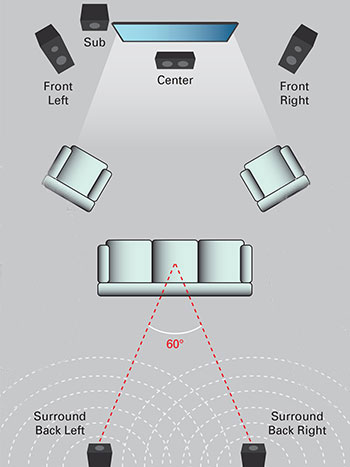5.1 Surround Sound Music Cd


However, there are a number of relatively cost-effective ways to burn surround audio to DVD or even CD. Surcode's CD-DTS (shown above) and DVD-DTS software packages will convert six mono audio files (all channels of the 5.1 format) to DTS-encoded WAVs on either CD or DVD, and cost $99 and $499 respectively. Our site is dedicated to the new music industry - a surround music! On our website you can always find and download the best albums of your favorite artists in the most popular formats DVD-Audio, DTS 5.1, SACD-R. Original Album In 5.1 Surround Sound. Here are more details for 77 CD-12 Love → Building On Fire. Also, currently I have 5 other rare Talking Heads 5.1 surround sound releases for sale.
| Optical discs |
|---|
|
|
|
The DTS Music Disc (official name),[1]DTS Audio CD or 5.1 Music Disc is an audio Compact Disc that contains music in one of various possible surround sound configurations. The specification permits discrete channel configurations from 2.0 (L, R) to 6.1 (L, R, C, LFE, Ls, Rs, Cs), although 5.1 (L, R, C, LFE, Ls, Rs) is the most common. Physically, a DTS Music Disc conforms to the Red Book standard; however a DTS bitstream, based on the Coherent Acoustics compression algorithm, is actually encapsulated in each PCM audio track. This configuration permits any non-DTS enabled player to output multi-channel audio when connected to an external DTS-compliant processor (e.g. a typical AV receiver) via a digital interface like S/PDIF or HDMI, provided that the player does not modify the bitstream internally.
Although the DTS audio track is read at the same fixed bitrate as 16-bit linear PCM (1,411 kbit/s) only 14 bits (1,234 kbit/s) are used for the encoded data stream; the remaining two bits are always zeros. This has the effect of attenuating the noise that would result (by roughly 12 dB) should one attempt to play a DTS Music Disc with a non-DTS system,[citation needed] and thereby reducing the chance of speaker damage. However this is a non-issue for players with internal DTS decoders, such as some DVD-Audio and Blu-ray players; these devices will output a properly decoded audio signal through their analogue ports.
Retrieved 9 April 2018. Retrieved 12 March 2018. 
Although all compliant DTS decoders support surround configurations of up to 5.1 channels, a DTS ES decoder must be used to fully decode discs with 6.0 or 6.1 channels of audio. DTS ES comes in two flavors: DTS ES Matrix and DTS ES Discrete. Depending on the disc and decoder used the Cs (center surround) channel will either be derived from the Ls and Rs of a conventional 5.1 track via matrix decoding, or exist as a fully discrete digital extension to a 5.0 or 5.1 core. In either case, backward compatibility is maintained with non-ES decoders.
References[edit]
Why did home theater buyers readily accept surround sound, but consistently reject multichannel music formats? From Thomas Edison's very first phonograph in 1877 through the late 1950s, monophonic sound was the only way people heard music at home.

Stereo arrived in the late 1950s on LP and analog reel-to-reel tape, and stereo has remained the most popular music format to this day. Quadraphonic (four-channel surround) debuted in the early 1970s, but didn't survive the end of the decade. People didn't want to plant four speakers in their living rooms, and the Quadraphonic Wars ensured the format's early demise. I remember massive confusion over the distinctions between CBS' SQ, Sansui's QS, and JVC's CD-4 LP quadraphonic formats; along with the various quad analog tape formats.
You would have thought that when the SACD and DVD-A multichannel audio formats debuted in the late 1990s they would have been embraced by the existing home theater market base. They already had all the speakers and a subwoofer, but the home theater crowd was uninterested in the two competing multichannel music formats. Besides, the folks who wanted to listen to music in surround were already doing so. Without investing a penny in an SACD or DVD-A player they could play all of their CDs with Dolby Pro Logic surround processing, and enjoy 5.1 surround from stereo CDs. That's still true today.
Two high-end speakers can create such a fully dimensional soundfield that few audiophiles were tempted to expand their hi-fis to 5.1-channel systems. In the early 2000s I reviewed lots of SACD and DVD-A players and discs, but as soon as that work dried up I happily returned to two-channel music.
Obviously, 5.1 surround makes sense for movies and home theater, mostly because 5.1 was a logical outgrowth of movie theater surround systems. Movies, after all, have had surround sound since the 1950s. Movies and surround go together like popcorn and Coke.
Music Cd 5.1 Surround Sound
Stereo doesn't even have a formidable music-surround format gearing up to challenge its long reign. Now that most people listen to music over headphones, a new surround music format would be an even tougher sell.
5.1 Surround Sound For Pc
Pixel 3A, the cheap phone Google's needed: No water resistance and no wireless charging, but Google packs the Pixel 3A with the features that matter.
5.1 Surround Sound Music
Google Nest Hub Max: A higher-end smart display for Google Assistant joins the Nest family, adds a camera.